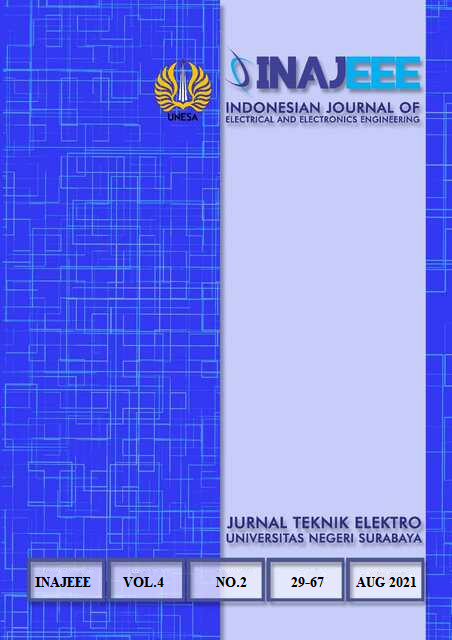Analysis of IEEE 802.15.4-Based Delay and Slot Duration Adjustment Combination Methods on Wireless Sensor Networks
DOI:
https://doi.org/10.26740/inajeee.v4n2.p51-58Keywords:
Wireless Sensor Networks (WSN), Goodput, Bandwith Utilization, Energy ConsumptionAbstract
IEEE 802.15.4 is one of the standards of the Wireless Sensor Network (WSN) which is at the Medium Access Control (MAC) layer. IEEE 802.15.4 is also technology and protocol within a computer network that can connect all device quickly, has a large capacity and low power consumption. The challenge of Wireless Sensor Network is how to improve the Wireless Sensor Network network performance matrix (goodput, bandwidth utilization, and energy consumption) both in the Contention Access Period (CAP) and in the Contention Free Period (CFP) based on the IEEE 802.15.4 standard. This research is an analysis combination of adjustment delay and slot duration methods to increase goodput, bandwidth utilization and reduce energy consumption in Wireless Sensor Networks in the allocation guaranteed time slots on fixed data simulated using Castalia Simulator software. The problem of this research is whether the combination method can improve the performance matrix of Wireless Sensor Networks on fixed data compared to other methods (SUDAS, ADES, IEEE 802.15.4 Standard). This reserch it aims to determine the performance matrix of combination methods is when compared to other methods (Superframe Duration Adjustment Scheme (SUDAS), Adjustment Delay Scheme (ADES), IEEE 802.15.4 standard) using quantitative approach research methods. Based on the data obtained, the goodput of the combined method increased by 10%, 416%, and 513% respectively compared to the SUDAS method, ADES method, and IEEE 802.15.4 standards. Bandwidth utilization of the combination methods increased by 0.025, 0.223 and 0.232, respectively compared to the SUDAS method, the ADES method, and the IEEE 802.15.4 standard. And the consumption of the combination methods are respectively reduced by 1.02%, 8.72% and 9.08% compared to the SUDAS, ADES and IEEE 802.15.4 standards. With the combination method of delay adjustment and slot duration it is able to optimize the performance of the Wireless Sensor Network compared to other methods.References
<p>[1] Arikunto, Suharsimi. Prosedur Penelitian Suatu Pendekatan Praktik. Jakarta: Rineka Cipta. 2006.</p><p class="DaftarPustaka">[2] Firdaus. Wirekess Sensor Network Teori dan Aplikasi. Yogyakarta : GrahaIlmu. 2014.</p><p class="DaftarPustaka">[3] Hardiansyah, Irzan. Schaum Online (jaringanKomputer). Jakarta : Erlangga (Alih Bahasa). 2014.</p><p class="DaftarPustaka">[4] Harsono, Galuh Dhatuningtyas. Analisis Pengalokasian Ukuran Guaranteed Time Slot Pada Wireless Body Area Network Berbasis IEEE 802.15.4. Surabaya: Universitas Negeri Surabaya (UNESA). 2017.</p><p>[5] IEEE 802.15.4. œPart 15.4: Wireless Medium Access Control (MAC) and Physical Layer (PHY) Specifications for Low-Rate Wireless Personal Area Networks (WPANs), IEEE standard for information technology, September 2006.</p><p>[6] Lee, Bih-Hwang, Yundra, Eppy, Wu, Huai-Kuei dan Al Rasyid, M Udin Harun. Analysis of Superframe Duration Adjustment Scheme for IEEE 802.15.4 networks. Dalam Springer Open Journal. Taiwan. 2015.</p><p>[7] Michael Shell. (2002) IEEEtran homepage on CTAN. [Online], archive/macros/latex/contrib/supported/IEEEtran/ , tanggal akses: 16</p><p>September 2014.</p><p class="DaftarPustaka">[8] Lee, Bih-Hwang, Yundra, Eppy, Wu, Huai-Kuei dan Al Rasyid, M Udin Harun. <em>Analysis of Superframe Duration Adjustment Scheme for IEEE 802.15.4 networks</em>. Dalam Springer Open Journal. Taiwan. 2015.</p><p class="DaftarPustaka"> </p>
Downloads
Published
2021-11-25
Issue
Section
Articles
License
Copyright (c) 2021 INAJEEE (Indonesian Journal of Electrical and Electronics Engineering)

This work is licensed under a Creative Commons Attribution-NoDerivatives 4.0 International License.
 Abstract views: 399
,
Abstract views: 399
, PDF Downloads: 224
PDF Downloads: 224




